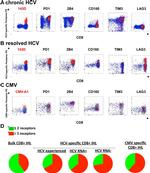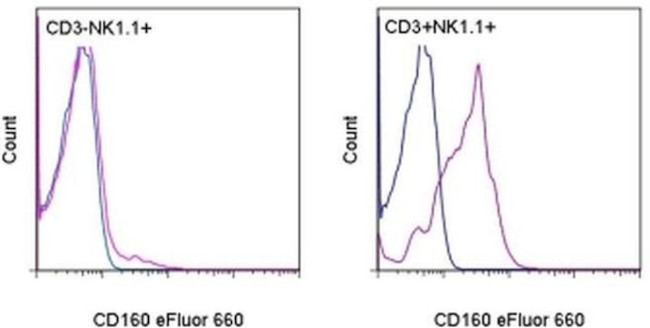Search Thermo Fisher Scientific
Invitrogen
CD160 Monoclonal Antibody (eBioCNX46-3 (CNX46-3)), eFluor™ 660, eBioscience™
FIGURE: 1 / 3
CD160 Antibody (50-1601-82) in Flow



Product Details
50-1601-82
Species Reactivity
Published species
Host/Isotype
Recommended Isotype Control
Class
Type
Clone
Conjugate
Excitation/Emission Max
Form
Concentration
Purification
Storage buffer
Contains
Storage conditions
Shipping conditions
RRID
Product Specific Information
Description: CD160 is a glycosylphosphatidylinositol (GPI)-anchored Ig-like glycoprotein first identified on human lymphocytes with the monoclonal antibody BY55. In mice, CD160 is expressed on almost all (intestinal intraepithelial lymphocytes) iIELs, NKT cells, most TCRgammadelta T cells, few NK cells and a minor subset of CD8+ T cells. Murine CD160 has been shown to bind to a wide range of classical and non classical MHC class I molecules and regulate NK cell activation. In vitro, CD3 activation of murine CD8+ T cells increases the expression of CD160 and induces the release of soluble CD160 (sCD160). In human, CD160 mAb cross-linking triggers TNF alpha, IFN gamma and IL-6 cytokine production by peripheral blood NK cells and inhibits tube formation and induces apoptosis of endothelial cells. In mice, cross-linking of CD160 with the CNX46-3 antibody regulates NK cell activation both positively and negatively, depending on the stimulus.
Applications Reported: This CNX46-3 antibody has been reported for use in flow cytometric analysis.
Applications Tested: This CNX46-3 antibody has been tested by flow cytometric analysis of mouse splenocytes. This can be used at less than or equal to 1 µg per test. A test is defined as the amount (µg) of antibody that will stain a cell sample in a final volume of 100 µL. Cell number should be determined empirically but can range from 10^5 to 10^8 cells/test. It is recommended that the antibody be carefully titrated for optimal performance in the assay of interest.
eFluor® 660 is a replacement for Alexa Fluor® 647. eFluor® 660 emits at 659 nm and is excited with the red laser (633 nm). Please make sure that your instrument is capable of detecting this fluorochome.
Excitation: 633-647 nm; Emission: 668 nm; Laser: Red Laser.
Filtration: 0.2 µm post-manufacturing filtered.
Target Information
CD160 is a receptor showing broad specificity for both classical and non-classical MHC class I molecules. CD160 is expressed at the cell surface as a tightly disulfide-linked multimer. It is involved in cell proliferation, cell surface receptor signaling pathways, cellular defense response, and regulation of immune response.
For Research Use Only. Not for use in diagnostic procedures. Not for resale without express authorization.
How to use the Panel Builder
Watch the video to learn how to use the Invitrogen Flow Cytometry Panel Builder to build your next flow cytometry panel in 5 easy steps.
Bioinformatics
Protein Aliases: CD160; CD160 antigen; natural killer cell BY55; natural killer cell receptor; Natural killer cell receptor BY55
Gene Aliases: AU045688; By55; Cd160
UniProt ID: (Mouse) O88875
Entrez Gene ID: (Mouse) 54215

Performance Guarantee
If an Invitrogen™ antibody doesn't perform as described on our website or datasheet,we'll replace the product at no cost to you, or provide you with a credit for a future purchase.*
Learn more
We're here to help
Get expert recommendations for common problems or connect directly with an on staff expert for technical assistance related to applications, equipment and general product use.
Contact tech support

